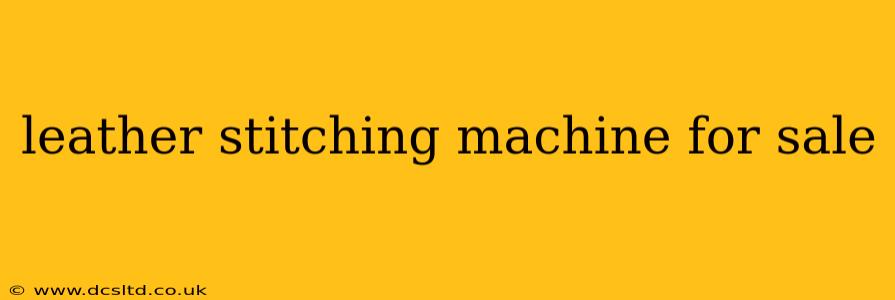Finding the right leather stitching machine can be a game-changer for leatherworkers, whether you're a seasoned professional or a passionate hobbyist. This guide explores various types of machines available for sale, factors to consider when purchasing, and answers common questions to help you make an informed decision.
What Types of Leather Stitching Machines Are For Sale?
Several types of leather stitching machines cater to different needs and budgets. The primary categories include:
-
Hand-Stitching Tools: These are ideal for beginners and smaller projects. They offer a personal touch and excellent control but can be time-consuming for large-scale work. This includes needles, awls, and stitching punches.
-
Walking Foot Sewing Machines: These are versatile machines capable of handling thicker materials like leather. The "walking foot" mechanism ensures even feed of the fabric and leather, preventing slippage and creating consistent stitches. Many standard sewing machines can be adapted with a walking foot attachment.
-
Industrial Sewing Machines: Designed for heavy-duty use, these machines offer speed, power, and durability. They're commonly used by professionals and for high-volume production. These typically require specific needles and thread designed for leather.
-
Specialized Leather Stitching Machines: These machines are specifically engineered for leatherwork, often featuring features like extra-strong needles, adjustable stitch length, and reinforced construction.
What Factors Should I Consider When Buying a Leather Stitching Machine?
Several key factors will influence your decision:
-
Budget: Prices range significantly, from affordable hand-stitching tools to high-end industrial machines. Determine your budget before browsing options.
-
Project Scope: If you're working on small craft projects, a hand-stitching kit might suffice. For larger projects or mass production, an industrial machine becomes more practical.
-
Leather Thickness: The thickness of the leather you typically work with will dictate the machine's power and needle capabilities. Thicker leather requires a more robust machine.
-
Stitch Type and Quality: Consider the desired stitch type (e.g., saddle stitch, straight stitch) and the level of stitch quality you require. Some machines offer more stitch options than others.
-
Ease of Use and Maintenance: Choose a machine that’s easy to operate and maintain, especially if you’re a beginner.
What are the Best Brands of Leather Stitching Machines?
Numerous reputable brands produce high-quality leather stitching machines. Researching specific models from these brands will reveal their features, specifications, and user reviews:
-
Singer: A well-known brand offering a range of sewing machines suitable for leatherwork, particularly their heavy-duty models with walking foot attachments.
-
Juki: A popular choice among professionals, known for their robust industrial sewing machines.
-
Durkopp Adler: Another leading brand in the industrial sewing machine market, offering powerful machines for leather and other heavy-duty materials.
(Note: This is not an exhaustive list, and many other quality brands exist.)
What is the Price Range for Leather Stitching Machines?
The price range is vast, depending on the type of machine:
-
Hand-Stitching Tools: Can cost from a few dollars to several hundred for a comprehensive kit.
-
Walking Foot Sewing Machines: Can range from a few hundred dollars to over a thousand, depending on features and brand.
-
Industrial Sewing Machines: Typically cost several thousand dollars, and even more for top-of-the-line models.
Where Can I Find Leather Stitching Machines For Sale?
Leather stitching machines are available from various sources:
-
Online Marketplaces: Sites like eBay, Amazon, and specialized leatherworking supply websites offer a wide selection.
-
Retail Stores: Some sewing machine retailers carry leather-capable machines or provide accessories for adapting existing machines.
-
Used Equipment Dealers: You might find used machines at significantly reduced prices, but thorough inspection is crucial.
-
Leatherworking Supply Stores: These stores often carry a selection of machines and hand tools.
What Maintenance is Required for a Leather Stitching Machine?
Regular maintenance extends the life of your machine. This includes:
-
Cleaning: Regularly remove lint, dust, and leather scraps.
-
Lubrication: Follow the manufacturer's instructions for lubricating moving parts.
-
Needle Replacement: Replace needles as needed to maintain stitch quality and prevent breakage.
-
Tension Adjustment: Periodically check and adjust the tension settings for optimal stitching.
By carefully considering these factors, you can select the perfect leather stitching machine to fuel your creativity and produce high-quality leather goods. Remember to read reviews, compare features, and choose a machine that aligns with your skill level, budget, and project requirements.
